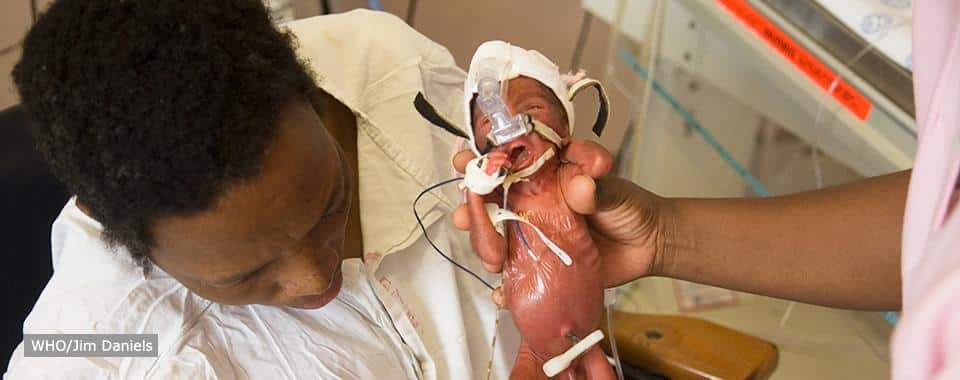Buyers Guides for Respiratory and Oxygen Support Products

Importance of Respiratory and Oxygen Support for Newborn
Adopted from WHO-UNICEF technical specifications and guidance for oxygen therapy devices. 2019
Despite progress in reducing infant and child deaths over the past twenty years, an estimated 6 million children and young adolescents die each year, most of which are from preventable causes such as birth complications, pneumonia, diarrhea, neonatal sepsis, and malaria. The highest risk occurs in the first month of life, with newborn mortality representing the majority of infant and child deaths globally. (1)
Every year, approximately 1.5 million babies and children die from causes related to Respiratory Distress Syndrome (RDS), pneumonia, asphyxia, sepsis, and other infections. For preterm babies, RDS is especially dangerous due to insufficient lung development, in which there is a deficiency of lung surfactant that is needed to keep the lungs from collapsing (alveolar collapse). These respiratory conditions can result in hypoxia, which is low levels of oxygen in the body, or oxygen saturation (Sp02) <90%.
Despite its importance in acute severe illnesses, hypoxia is often not well recognized or managed in settings where resources are limited and can result in excess mortality and morbidity. Depending on the resources at the healthcare facility, local health guidelines, and patient requirements, the providers will need to decide on a breathing support, or ventilation strategy, that is gentle enough and effective enough to help the baby breathe, and avoids oxygen toxicity, all of which will depend on the baby’s size, health status, and if the baby is doing some of his or her own breathing already. Oxygen is essential for treatment of hypoxia; and with adequate tools and regular training, respiratory and oxygen support can be life-saving.
To reduce newborn and child deaths from respiratory illnesses, health workers must know the clinical signs of hypoxia, and have access to supplemental oxygen and respiratory support devices as essential life-saving treatment options. VIA’s Buyers Guides for Respiratory and Oxygen Support include specific respiratory devices as well as basic supplemental oxygen but the skills of the health workers, infrastructure of the healthcare environment, and local policies and guidelines are the most important factors in selecting the appropriate solutions.
Newborns should reach oxygen saturation ((Sp02) levels of 90-95% by 15 minutes after birth. Supplemental oxygen should typically be between 0.5-1L/min and the newborn’s oxygen should be monitored using a pulse oximeter.
Oxygen therapy for children. (World Health Organization, 2016).
Types of Solutions for Respiratory and Oxygen Support
Ensuring that sick newborns and premature babies are sufficiently healthy and ready to go home requires a holistic and integrated system of technologies that includes everything from supplemental oxygen (either produced locally at a health facility or delivered and stored) and devices for flow regulation and conditioning of oxygen which provide breathing support, to consumables for oxygen delivery to the patient. In addition, pulse oximetry is used to detect hypoxia and monitor oxygen saturation during oxygen therapy for respiratory difficulty. Finally, devices for continuity of power and power quality, devices for monitoring oxygen concentration, and spare parts for equipment maintenance, along with the capacity to maintain them, are also essential components of effective oxygen systems.
The graphic below represents a comprehensive oxygen solution and the tools that are necessary to provide oxygen support to a patient, adult or pediatric, who needs help breathing.
Such tools include:
- Sources of oxygen: including concentrators, cylinders, or pipelines, which can offer the most consistent and cost-effective supply of oxygen in health facilities.
- Respiratory Support Devices such as bCPAPs, resuscitators, suction devices, and ventilators
- Oxygen Accessories for Delivery, and Regulation methods: airway interfaces, tubing, flowmeters and flowsplitters, humidifiers, and blenders
- Oxygen Monitoring with Pulse oximetry: pulse oximeters are critical for diagnosing hypoxemia and monitoring oxygen saturation
Ensuring that sick newborns and premature babies are sufficiently healthy and ready to go home requires a holistic and integrated system of technologies that includes everything from supplemental oxygen (either produced locally at a health facility or delivered and stored) and devices for flow regulation and conditioning of oxygen which provide breathing support, to consumables for oxygen delivery to the patient. In addition, pulse oximetry is used to detect hypoxaemia and monitor oxygen saturation during oxygen therapy for respiratory difficulty. Finally, devices for continuity of power and power quality, devices for monitoring oxygen concentration, and spare parts for equipment maintenance, along with the capacity to maintain them, are also essential components of effective oxygen systems.

Adopted from WHO-UNICEF technical specifications and guidance for oxygen therapy devices. 2019
UNICEF has developed an excel-based planning tool, found here, to help health facilities and other stakeholders at local, regional, and national levels plan their oxygen supply system, from the source of oxygen through to the patient delivery device. This tool can be useful for health facilities and those who make procurement choices to understand the different solutions and what might be most appropriate for their setting to improve oxygen availability and delivery.
Outlined below are technologies that provide breathing and oxygen support for newborns, and VIA Buyers Guides for products* as a resource for purchasing decision-making.
Essential Newborn Care requires far more than just equipment and supplies included in this Buyers Guide; VIA Global Health recommends consulting the WHO Guidelines on Basic Newborn Resuscitation and the Helping Babies Breathe, 2nd Edition as well as local clinical protocols and guidelines.
Related Buyers Guides
VIA Global Health is committed to supporting health systems access affordable and appropriate medical products to improve the health in their communities. Products included in our Buyers Guides are available for purchase at VIA Global Health
(1) World Health Organization, 2018. Levels and trends in child mortality report 2018
(2) IHME https://ourworldindata.org/child-mortality#what-are-children-dying-from
(3) World Health Organization, 2016. Oxygen therapy for children. Geneva, Switzerland.
Molyneux E., Werdenberg J., Liaghati-Mobarhan S. & Langton J., NEST360. Newborn Essential Solutions and Technologies-Education – Clinical Modules. (June 2020). License: CC BY-NC-SA 4.0.
